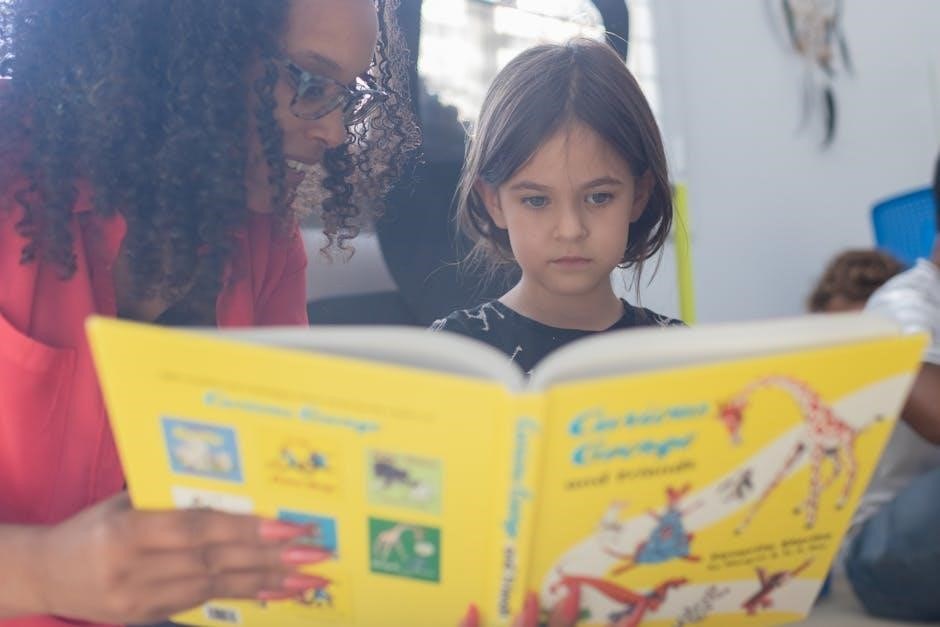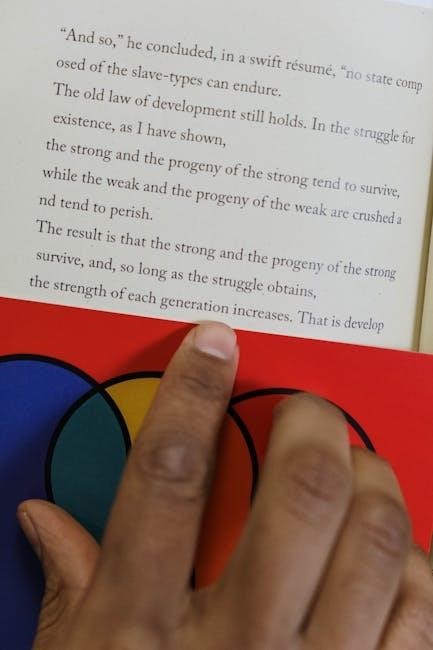
reading comprehension year 7 pdf
Reading Comprehension Year 7 PDF: An Article Plan
This article provides a structured plan for understanding and improving reading comprehension skills for Year 7 students. We will explore key skills, strategies, and resources, including free printable worksheets and effective test-taking techniques, all in PDF format.
Understanding Reading Comprehension for Year 7
Reading comprehension in Year 7 goes beyond simply decoding words; it involves a deeper understanding of the text’s meaning. At this stage, students should be able to grasp the main idea, identify supporting details, and understand the author’s purpose. This skill is crucial for academic success across all subjects, as it forms the foundation for learning from written materials.
Effective reading comprehension involves active engagement with the text, including asking questions, making connections, and summarizing key points. Year 7 students should also be able to infer meaning from context clues, analyze text structure, and evaluate the author’s perspective. Mastering these skills will enable them to navigate complex texts and extract relevant information.
Furthermore, understanding different text types, such as fiction, non-fiction, and poetry, is essential for Year 7 students. Each text type requires a different approach to comprehension, and students should be able to adapt their reading strategies accordingly. By developing these skills, students will become confident and proficient readers.
Importance of Reading Comprehension Skills
Reading comprehension skills are paramount for Year 7 students, impacting not only their academic performance but also their overall personal development. Strong reading comprehension enables students to access information, understand complex ideas, and engage critically with the world around them. It is a foundational skill that supports learning in all subject areas, from science and history to mathematics and literature.
Moreover, effective reading comprehension fosters critical thinking, problem-solving, and analytical skills. Students who can understand and interpret texts effectively are better equipped to evaluate arguments, form their own opinions, and participate in informed discussions. These skills are essential for success in higher education and in the workplace.
Furthermore, reading comprehension enhances vocabulary, improves writing skills, and expands general knowledge. By reading widely and deeply, students encounter new words and concepts, which enriches their language skills and broadens their understanding of the world. Ultimately, strong reading comprehension skills empower students to become lifelong learners and engaged citizens.
Benefits of Improved Reading Comprehension
Improved reading comprehension offers a multitude of benefits for Year 7 students, extending far beyond the classroom. Academically, students with strong comprehension skills tend to achieve higher grades, as they can readily understand and retain information from textbooks, articles, and other learning materials. This leads to increased confidence and motivation, fostering a positive attitude towards learning.
Furthermore, enhanced reading comprehension supports critical thinking and problem-solving abilities. Students can analyze complex texts, identify key arguments, and draw logical conclusions. This skill is invaluable in various academic disciplines and real-world situations, empowering students to make informed decisions and solve problems effectively.
Moreover, improved reading comprehension broadens students’ horizons and expands their knowledge base. By engaging with diverse texts, students encounter new ideas, perspectives, and cultures, fostering empathy and understanding. This contributes to their personal growth and prepares them to be informed and engaged citizens in a globalized world. Ultimately, improved reading comprehension unlocks a world of opportunities for Year 7 students, empowering them to succeed academically, personally, and professionally.

Free Reading Comprehension Resources
Discover a wealth of free resources to support Year 7 reading comprehension! Explore printable worksheets and PDFs designed to enhance reading skills and understanding, readily accessible online for convenient practice.
Free Printable Worksheets for Year 7
Unlock a world of learning with our collection of free printable worksheets specifically designed for Year 7 reading comprehension. These worksheets offer a diverse range of exercises to bolster crucial reading skills. From short passages to longer texts, these resources provide ample opportunities for practice.

Enhance reading abilities through engaging activities that focus on understanding the main idea, vocabulary acquisition, and inference skills. These free, readily accessible worksheets cater to diverse learning styles and are perfect for classroom use or at-home practice. Download and print these valuable tools to help Year 7 students excel in reading.
These resources often include questions designed to test understanding and promote critical thinking. Take advantage of these free materials to support your student’s reading journey and boost their confidence in tackling complex texts. With regular use, these worksheets can significantly improve reading comprehension skills.
Where to Find Free Reading Comprehension PDFs
Discovering free reading comprehension PDFs for Year 7 students is easier than you think! Numerous websites offer downloadable resources to enhance reading skills. Educational platforms often provide a wealth of free worksheets and passages suitable for this age group. Look for sites that specialize in educational materials and resources.
Many teachers and educators share their resources online, creating a treasure trove of free content. Search for educational blogs, online libraries, and websites dedicated to homeschooling resources. Some websites may require registration, but offer access to a vast collection of reading comprehension materials.

Be sure to check reputable educational publishers’ websites, as they often provide sample PDFs for free download. These PDFs can be invaluable tools for reinforcing reading skills and preparing students for academic success. Take the time to explore these online resources and find the perfect materials to support your Year 7 student’s reading journey.

Key Reading Comprehension Skills for Year 7
Year 7 reading comprehension involves several key skills: identifying the main idea, understanding vocabulary, making inferences, and analyzing text structure. Mastering these skills is crucial for academic success.
Identifying the Main Idea
Identifying the main idea is a fundamental reading comprehension skill for Year 7 students. It involves discerning the central point or message that the author is conveying in a text. This skill requires students to look beyond the surface details and understand the overall purpose of the writing.
To effectively identify the main idea, students should consider the following strategies: first, scan the text to get a general sense of the topic; look for repeated words or phrases, as these often indicate key themes; pay attention to the introductory and concluding paragraphs, as they often summarize the main idea; and finally, ask yourself, “What is the author primarily trying to communicate?”
Practice with various texts, including short stories, articles, and informational passages, can help students develop this skill. Worksheets and exercises that specifically focus on identifying the main idea can also be valuable resources. By mastering this skill, students will improve their overall reading comprehension and ability to understand complex texts.
Understanding Vocabulary in Context
Understanding vocabulary in context is crucial for Year 7 reading comprehension. It’s not just about memorizing definitions; it’s about deciphering the meaning of unfamiliar words based on how they are used within a sentence or passage. This skill allows students to grasp the nuances of language and comprehend complex ideas effectively.
To improve this skill, encourage students to look for clues within the surrounding text. These clues can include definitions, examples, synonyms, antonyms, or the overall tone of the passage. Teach them to break down the sentence and analyze how the unfamiliar word relates to other words and ideas.
Provide opportunities for students to practice using context clues through targeted exercises and activities. Encourage them to read widely and to actively engage with the text by highlighting unfamiliar words and attempting to infer their meaning. Emphasize that understanding vocabulary in context is an ongoing process that enhances reading comprehension and expands their overall vocabulary.
Making Inferences and Drawing Conclusions
Making inferences and drawing conclusions are vital reading comprehension skills for Year 7 students. These skills involve going beyond the explicitly stated information in a text to understand the implied meanings and arrive at logical conclusions. It’s like being a detective, using clues from the text to solve a mystery.
To develop these skills, encourage students to actively engage with the text by asking questions and making predictions. Teach them to identify key details and consider the author’s purpose, tone, and perspective. Help them understand how to connect different parts of the text and identify patterns or relationships.
Provide opportunities for students to practice making inferences and drawing conclusions through targeted exercises and discussions. Use graphic organizers to help them visualize the connections between ideas. Emphasize that inferences and conclusions should be based on evidence from the text, not just personal opinions or assumptions. By mastering these skills, students can become more critical and insightful readers.
Analyzing Text Structure
Analyzing text structure is a crucial skill for Year 7 students to enhance their reading comprehension. Recognizing how a text is organized helps readers understand the author’s message and navigate the information more effectively. Different text structures serve different purposes, and understanding them allows students to anticipate the content and follow the author’s line of reasoning.
Common text structures include description, sequence, cause and effect, compare and contrast, and problem and solution. Teaching students to identify these structures involves looking for signal words or phrases that indicate the relationship between ideas. For example, “because” and “therefore” signal cause and effect, while “similarly” and “however” suggest comparison and contrast.
Encourage students to create graphic organizers, such as flowcharts or Venn diagrams, to visually represent the text structure. This helps them break down complex information into manageable parts and see how the ideas connect. By mastering the ability to analyze text structure, students can improve their comprehension, retention, and critical thinking skills.

Strategies for Improving Reading Comprehension
Enhance Year 7 reading comprehension with strategies focusing on active reading, note-taking, and summarizing. These techniques empower students to engage deeply with texts and improve understanding through focused practice and skill development.
Active Reading Techniques
Active reading is crucial for Year 7 students aiming to boost their reading comprehension skills. This involves engaging with the text in a dynamic way, rather than passively reading words. One effective technique is highlighting or underlining key information, such as main ideas, supporting details, and important vocabulary.
Another useful strategy is asking questions while reading. Encourage students to pause and reflect on what they’ve read, posing questions like “What is the author’s purpose?” or “How does this relate to what I already know?”.
Annotating the text with notes, summaries, and personal connections can also significantly improve comprehension. This helps students to process and retain information more effectively, making active reading a powerful tool.
Furthermore, predicting what will happen next or anticipating the author’s arguments keeps students mentally engaged and improves their understanding of the text’s overall message. These techniques transform reading from a passive activity to an active, engaging process.
Note-Taking Strategies
Effective note-taking is an essential skill for Year 7 students aiming to enhance their reading comprehension. Note-taking involves summarizing key information and organizing it in a way that facilitates understanding and recall. One strategy is using the Cornell note-taking method, which divides the page into sections for notes, cues, and summaries.
Another effective approach is mind mapping, where students visually represent the relationships between different concepts and ideas. This can be particularly helpful for understanding complex texts with multiple themes or arguments.
Students can also use outlining to structure their notes, organizing information into main points and sub-points. This helps to identify the text’s main ideas and supporting details.

Encourage students to use abbreviations, symbols, and keywords to speed up the note-taking process. However, ensure that the notes remain clear and understandable for future review. Regular practice with these strategies will significantly improve comprehension and retention.
Summarizing and Paraphrasing
Summarizing and paraphrasing are crucial skills for Year 7 students to master in order to improve their reading comprehension. Summarizing involves condensing a text into its main points, highlighting the most important information in a concise manner. This requires students to identify the central ideas and supporting details, omitting unnecessary information.
Paraphrasing, on the other hand, involves restating a passage in one’s own words while maintaining the original meaning. This helps students to fully understand the text and avoid plagiarism. Effective paraphrasing requires a strong vocabulary and the ability to rephrase sentences without altering the original message.
To practice these skills, students can start by reading a short passage and then writing a brief summary in their own words. They can also try paraphrasing individual sentences or paragraphs to improve their understanding of the text. Regular practice with summarizing and paraphrasing will significantly enhance reading comprehension and critical thinking skills.

Test-Taking Strategies for Reading Comprehension
This section outlines effective test-taking strategies for Year 7 reading comprehension assessments. We will cover time management, question types, and metacognitive skills to help students perform their best and achieve success in reading tests.
Time Management Techniques
Effective time management is crucial for success in reading comprehension tests. Year 7 students can benefit from specific strategies that help them allocate their time wisely and avoid rushing through passages and questions.
Begin by previewing the entire test to gauge the number of passages and questions. Estimate the time needed for each section, allocating more time to longer or more complex passages. It’s vital to stick to the allocated time for each passage to ensure all sections are attempted;
During the test, skim the questions before reading the passage. This helps identify key information to look for, saving time on rereading. When answering questions, don’t spend too long on a single question; if unsure, mark it and return later if time permits.
Practicing with sample tests under timed conditions is essential. This helps students become familiar with the test format and refine their time management skills. By implementing these strategies, students can approach reading comprehension tests with confidence and efficiency.
Understanding Question Types

Familiarizing Year 7 students with various question types is vital for acing reading comprehension tests. Different questions require different approaches, and understanding these nuances can significantly improve performance. Common question types include:
Main Idea Questions: These ask about the central theme or purpose of the passage. Look for recurring ideas or statements that summarize the text’s overall message.
Detail Questions: These focus on specific information presented in the passage. Scan the text for keywords or phrases that match the question.
Inference Questions: These require reading between the lines and drawing conclusions based on the information provided. Look for clues or hints in the text.
Vocabulary Questions: These test understanding of word meanings in context. Use surrounding sentences to determine the word’s meaning within the passage.
Author’s Purpose Questions: These ask about the author’s intent or reason for writing the passage. Consider the tone, style, and content of the text.
By recognizing these question types and practicing strategies for answering each, students can approach reading comprehension tests with greater confidence and accuracy.
Using Metacognitive Skills
Metacognitive skills, or “thinking about thinking,” are crucial for success in reading comprehension. For Year 7 students, developing these skills can significantly enhance their ability to understand and retain information from texts. Metacognition involves being aware of one’s own thought processes during reading and actively monitoring comprehension.
Effective metacognitive strategies include:

Self-Questioning: Asking oneself questions before, during, and after reading to check understanding. For example, “What is this passage about?” or “Do I understand what I just read?”
Monitoring Comprehension: Paying attention to whether the text makes sense and identifying any areas of confusion. If comprehension breaks down, rereading or using other strategies may be necessary.
Predicting: Making predictions about what will happen next in the text based on prior knowledge and clues from the passage.
Evaluating: Assessing the accuracy and reliability of the information presented in the text.
Reflecting: Thinking about what has been learned from the text and how it relates to existing knowledge.
By consciously employing these metacognitive skills, Year 7 students can become more active and engaged readers, leading to improved comprehension and retention.